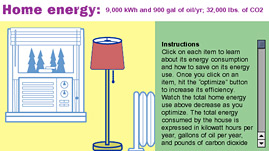The United States is responsible for one-quarter of the world's energy consumption, mostly the result of burning fossil fuels. This means that each American is directly or indirectly responsible for the release of approximately 20 tons of carbon dioxide (CO2) into the air each year.* We all know that cars burn gas like it is going out of style (and it may well someday). Heating and lighting our homes also takes a significant amount of energy. But what about video games, fish tanks, computers, and other nonessentials? A typical U.S. family spends close to $1,300 per year on home utility bills, much of it on wasted energy. By taking some simple steps, it is possible to drastically reduce the amount of energy you use -- and in turn reduce your utility bills as well as the amount of CO2 that gets pumped into the atmosphere. Look around the typical New England house presented in this interactive and click on the various items. You'll see where all that energy goes and learn how to make your home more energy efficient. This simulation is not meant to be a definitive guide to energy savings but rather offers some common-sense suggestions that can reduce your home's energy consumption and save you money. *Note that the factor for converting electricity to carbon emissions varies from region to region. In this feature, New England's carbon emission factors were used.


 Loading Standards
Loading Standards Teachers' Domain is proud to be a Pathways portal to the National Science Digital Library.
Teachers' Domain is proud to be a Pathways portal to the National Science Digital Library.
